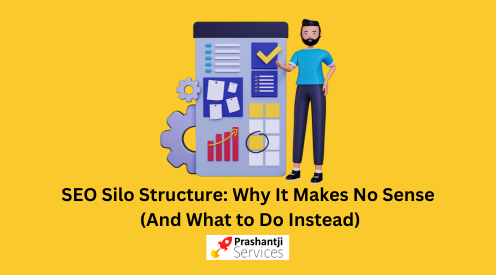SEO Silo Structure: Why It Makes No Sense (And What to Do Instead)
Introduction:
In the world of Search Engine Optimization (SEO), website owners are always on the lookout for strategies to improve their rankings and drive more organic traffic. One such strategy that gained popularity in the past was the SEO silo structure.
The idea behind the silo structure was to organize content into specific categories or “silos,” with each silo focusing on a particular keyword. However, as SEO has evolved, so has the understanding of effective content organization and user intent.
In this article, we will explore why the traditional SEO silo structure no longer makes sense and what alternative approach can yield better results.
Understanding Silo Structure:
The concept of silo structure involves grouping related content together within a website. Each silo typically covers a specific topic or keyword, and the content within it is internally linked to establish topical relevance.
The intention was to make it easier for search engine crawlers to understand the content’s context and relevance to a given keyword.
The Myth of SEO Silo Structure:
While the silo structure might have sounded logical in theory, it has its fair share of misconceptions. One common myth is that using a silo structure automatically boosts a website’s SEO rankings.
However, search engines have become more sophisticated, and they now prioritize content that satisfies user intent and provides comprehensive information.
Drawbacks of SEO Silo Structure:
Despite its initial appeal, the silo structure has several drawbacks that can hinder a website’s overall SEO performance. Firstly, interlinking between silos can be complicated, making it difficult for users and search engines to navigate the website seamlessly.
Additionally, a siloed approach often results in limited topical authority, as each silo is only optimized for a specific keyword, neglecting the broader context.
Furthermore, focusing solely on individual silos may lead to a disjointed user experience, as users might need to jump between different sections to find related information. This can increase bounce rates and negatively impact overall user satisfaction.
Modern SEO Best Practices:
Modern SEO is centered around providing value to users. Instead of fixating on individual keywords, today’s approach emphasizes understanding user intent and creating content that satisfies those intents. One effective way to achieve this is through the use of topical clusters.
Creating an Effective SEO Content Structure:
To implement a successful content structure, conducting thorough keyword research is essential. Identify relevant topics and group them into clusters. Each cluster should revolve around a pillar page, covering the core topic in-depth, and linked to cluster pages that delve into subtopics.
Internal Linking Strategies:
Internal linking is a crucial aspect of SEO, as it establishes connections between different pieces of content on your website. Strategic internal linking within topic clusters can boost the overall topical authority of your site and improve user navigation.

Benefits of Topic Clusters:
Topic clusters offer several advantages over traditional silo structures. By organizing content around user intent and comprehensive topics, your website becomes more user-friendly. Users can easily find related information, leading to longer session durations and increased engagement.
Moreover, search engines recognize the contextual relevance of your content better when it’s structured in topic clusters. This can result in improved rankings for a wider range of related keywords.
Mobile-First Approach:
In today’s mobile-centric world, having a mobile-friendly website is crucial for SEO success. A content structure based on topic clusters lends itself well to mobile responsiveness, ensuring that your site delivers a seamless experience to mobile users.
Evaluating Your Website Structure:
Before transitioning away from silo structure, it’s essential to evaluate your current website’s performance. Use analytics tools to assess user behavior, identify pages with high bounce rates, and determine areas for improvement.
Transitioning Away from Silo Structure:
Migrating from a silo structure to a topic cluster approach requires careful planning and execution. Start by mapping out your topic clusters and creating pillar pages with comprehensive content.
Gradually redirect your existing content to fit within the new structure and update internal links accordingly.
Tracking and Measuring SEO Success:
During and after the transition, monitor key performance indicators (KPIs) to gauge the impact on your SEO performance. Keep an eye on organic traffic, rankings, and user engagement metrics to ensure the new approach is yielding positive results.
Addressing Common Concerns:
It’s natural to have concerns about making significant changes to your SEO strategy. Address common worries, such as fears of losing rankings during the transition, and provide reassurance that a well-executed shift to a topic cluster approach can lead to long-term benefits.
Future-Proofing Your SEO Strategy:
SEO is a dynamic field, with search engines frequently updating their algorithms. To future-proof your SEO strategy, stay informed about industry trends, algorithm updates, and emerging best practices.
Adapt your content structure and SEO tactics accordingly to maintain a competitive edge.
Conclusion:
In conclusion, while the SEO silo structure might have been a popular approach in the past, it’s no longer the most effective strategy for ranking high in search engine results. Emphasizing user intent, content relevance, and a comprehensive topic cluster approach is the way forward for modern SEO success. By embracing this change and putting users at the center of your content strategy, you can achieve higher rankings, increased organic traffic, and a more satisfying user experience.








